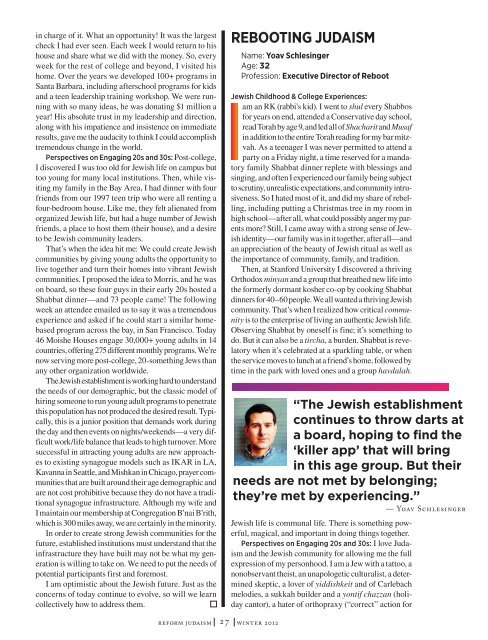reform judaism - UAHC
reform judaism - UAHC
reform judaism - UAHC
- No tags were found...
You also want an ePaper? Increase the reach of your titles
YUMPU automatically turns print PDFs into web optimized ePapers that Google loves.
in charge of it. What an opportunity! It was the largestcheck I had ever seen. Each week I would return to hishouse and share what we did with the money. So, everyweek for the rest of college and beyond, I visited hishome. Over the years we developed 100+ programs inSanta Barbara, including afterschool programs for kidsand a teen leadership training workshop. We were runningwith so many ideas, he was donating $1 million ayear! His absolute trust in my leadership and direction,along with his impatience and insistence on immediateresults, gave me the audacity to think I could accomplishtremendous change in the world.Perspectives on Engaging 20s and 30s: Post-college,I discovered I was too old for Jewish life on campus buttoo young for many local institutions. Then, while visitingmy family in the Bay Area, I had dinner with fourfriends from our 1997 teen trip who were all renting afour-bedroom house. Like me, they felt alienated fromorganized Jewish life, but had a huge number of Jewishfriends, a place to host them (their house), and a desireto be Jewish community leaders.That’s when the idea hit me: We could create Jewishcommunities by giving young adults the opportunity tolive together and turn their homes into vibrant Jewishcommunities. I proposed the idea to Morris, and he wason board, so these four guys in their early 20s hosted aShabbat dinner—and 73 people came! The followingweek an attendee emailed us to say it was a tremendousexperience and asked if he could start a similar homebasedprogram across the bay, in San Francisco. Today46 Moishe Houses engage 30,000+ young adults in 14countries, offering 275 different monthly programs. We’renow serving more post-college, 20-something Jews thanany other organization worldwide.The Jewish establishment is working hard to understandthe needs of our demographic, but the classic model ofhiring someone to run young adult programs to penetratethis population has not produced the desired result. Typically,this is a junior position that demands work duringthe day and then events on nights/weekends—a very difficultwork/life balance that leads to high turnover. Moresuccessful in attracting young adults are new approachesto existing synagogue models such as IKAR in LA,Kavanna in Seattle, and Mishkan in Chicago, prayer communitiesthat are built around their age demographic andare not cost prohibitive because they do not have a traditionalsynagogue infrastructure. Although my wife andI maintain our membership at Congregation B’nai B’rith,which is 300 miles away, we are certainly in the minority.In order to create strong Jewish communities for thefuture, established institutions must understand that theinfrastructure they have built may not be what my generationis willing to take on. We need to put the needs ofpotential participants first and foremost.I am optimistic about the Jewish future. Just as theconcerns of today continue to evolve, so will we learncollectively how to address them.REBOOTING JUDAISMName: Yoav SchlesingerAge: 32Profession: Executive Director of RebootJewish Childhood & College Experiences:am an RK (rabbi’s kid). I went to shul every Shabbosfor years on end, attended a Conservative day school,read Torah by age 9, and led all of Shacharit and Musafin addition to the entire Torah reading for my bar mitzvah.As a teenager I was never permitted to attend aparty on a Friday night, a time reserved for a mandatoryfamily Shabbat dinner replete with blessings andsinging, and often I experienced our family being subjectto scrutiny, unrealistic expectations, and community intrusiveness.So I hated most of it, and did my share of rebelling,including putting a Christmas tree in my room inhigh school—after all, what could possibly anger my parentsmore? Still, I came away with a strong sense of Jewishidentity—our family was in it together, after all—andan appreciation of the beauty of Jewish ritual as well asthe importance of community, family, and tradition.Then, at Stanford University I discovered a thrivingOrthodox minyan and a group that breathed new life intothe formerly dormant kosher co-op by cooking Shabbatdinners for 40–60 people. We all wanted a thriving Jewishcommunity. That’s when I realized how critical communityis to the enterprise of living an authentic Jewish life.Observing Shabbat by oneself is fine; it’s something todo. But it can also be a tircha, a burden. Shabbat is revelatorywhen it’s celebrated at a sparkling table, or whenthe service moves to lunch at a friend’s home, followed bytime in the park with loved ones and a group havdalah.“The Jewish establishmentcontinues to throw darts ata board, hoping to find the‘killer app’ that will bringin this age group. But theirneeds are not met by belonging;they’re met by experiencing.”— Yoav SchlesingerJewish life is communal life. There is something powerful,magical, and important in doing things together.Perspectives on Engaging 20s and 30s: I love Judaismand the Jewish community for allowing me the fullexpression of my personhood. I am a Jew with a tattoo, anonobservant theist, an unapologetic culturalist, a determinedskeptic, a lover of yiddishkeit and of Carlebachmelodies, a sukkah builder and a yontif chazzan (holidaycantor), a hater of orthopraxy (“correct” action for<strong>reform</strong> <strong>judaism</strong> 27 winter 2012


